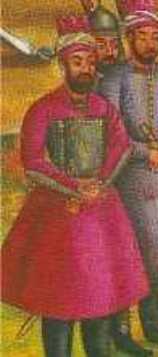Mirza Mehdi Khan Astarabadi
| Mirza Mehdi Khan Esterabadi | |
|---|---|
 | |
| Born | 18th century |
| Died | 18th century |
Mirza Mehdi Khan Astarabadi (Persian: میرزا مهدی خان استرآبادی), also known as Etemad-ed-Dowleh (اعتماد الدوله) and Monshi-ol-Mamalek (منشی الممالک) (born and died in the 18th century) was the chief secretary, historian, biographer, advisor, strategist, friend and confidant of King Nadir Shah Afshar, it was he who wrote and accepted the different decisions and files related to the Empire.
Biography
Mirza Mehdi Khan, son of Mohammad Nassir, spent his young life in Isfahan where he frequented the Royal Court during the Safavid period. During the reign of the last Safavid King, the Afghans attacked Iran. When military chief Nader Shah expelled the Afghans, Mirza Mehdi Khan supported him in the Safavid court.
Mirza Mehdi was named private secretary, historian, and strategist of the imperial court at the time Nader Shah became emperor of Persia (Iran) and became Nader Shah Afshar (1736-1747).
In 1747, Mirza was sent as an ambassador to the Ottoman Empire. However, when he learned about the death of Nader Shah, he was forced to go back to Iran.
Work
He was the author of historical books such as Tarikh-e-Jahangoshay-e-Naderi (History of Nadir Shah's Wars), which is a book studied in the Yale University and has this presentation : « Tarikh-i Nadiri. A history of Nadir shah Afshar, who ruled Iran from 1736 to 1747, written in Persian by Mahdi Khan Astarabadi (d. 1759), his secretary and court historian ». This book was also the object of research in 1996 by United States Naval Academy. Mirza Mehdi Khan also wrote "Dareh Nadareh" and "A Persian Guide to the Turkish Language" in 1759 with an introduction of Sir Gerard Clauson.
In 1768, King Christian VII of Denmark visited England. He took with him the book of Nader Shah, written by Mirza Mehdi Khan and asked Sir William Jones (1746-1794), orientalist and specialist in the history of old India, to translate it into French. This, in turn, led to the publication of the book, "Histoire de Nader Chah", in 1770.
Wars
In 1719, the Ghilzai Afghans of Kandahar, rebelled against the Safavid shah of Persia and invaded the capital Isfahan. They deposed Sultan Husayn,the reigning Shah of the Safavid dynasty in 1722. Their ruler, Mahmoud Afghan (±1699-1725), murdered a large number of Safavid Princes, hacking many of them to death by his own hand. After he had invited the leading citizens of Esfahan to a feast and massacred them there, his own supporters assassinated Mahmoud in 1725. His cousin, Ashraf (±1700-1730), took over and married a Safavid princess.
At first, Nader fought with the Afghans against the Uzbeks until they withheld him further payment. In 1727 Nader offered his services to Tahmasp II (±1704-1740), heir to the Safavid dynasty. Nader started the reconquest of Persia and drove the Ghilzai's out of Khorasan. The Ghilzai's suffered heavy losses, but before they fled Ashraf massacred an additional 3000 citizens of Esfahan. Most of the fleeing Afghans were soon overtaken and killed by Nader's men, while others died in the desert. Ashraf himself was hunted down and murdered.
By 1729 Nader had freed Persia from the HotakiAfghans. Tamasp II was crowned Shah, although he was little more than a figurehead. While Nader was putting down a revolt in Khorasan, Tamasp moved against the Ottoman Turks, losing Georgia and Armenia. Enraged, Nader deposed Tamasp in 1732 and installed Tamasp's infant son, Abbas III (1732-1740), on the throne, naming himself regent. Within two years Nader recaptured the lost territory and extended the Empire at the expense of the Turks and the Russians.
In 1736, Nader evidently felt that his own position had been established so firmly that he no longer needed to hide behind a nominal Safavid Shah and ascended the throne himself. In 1738 he invaded Kandahar, captured Kabul and marched on to India. He seized and sacked Delhi and, after some disturbances, he killed 30000 of its citizens. He plundered the Indian treasures of the Moghal Emperors, taking with him the famous jewel-encrusted Peacock Throne and the Koh-i Noor diamond. In 1740 Nader had Tamasp II and his two infant sons put to death. Then he invaded Transoxiana. He resumed war with Turkey in 1743. In addition, he built a navy and conquered Oman and its main capital the city of Muscat.
References
Biography of Mirza Mehdi Khan Esterabadi
Biography of Mirza Mehdi Khan Esterabadi in Encyclopaedia Iranica
Sources
- Esterabadi, Mirza Mehdi Khan (1368–1989). "The History of Nader Shah Afshar". Donyaye Ketab.
- Soltani, Ali (1994). "Historical Georgraphy & Comprehensive History of Kermanshahan". soha.
- Nabi, Hadi (1995). "Dictionary of Indo-Persian Literature". Abhinav.
- Narayan Jagadish, Sarkar (1982). "Romance of Historiography from Shah Alam I to Shah Alam II (non-European)". Ratna Prakashan.
- Soltani, Mohammad Ali (1999). "political parties & secret societies in Kermanshah". Tehran.